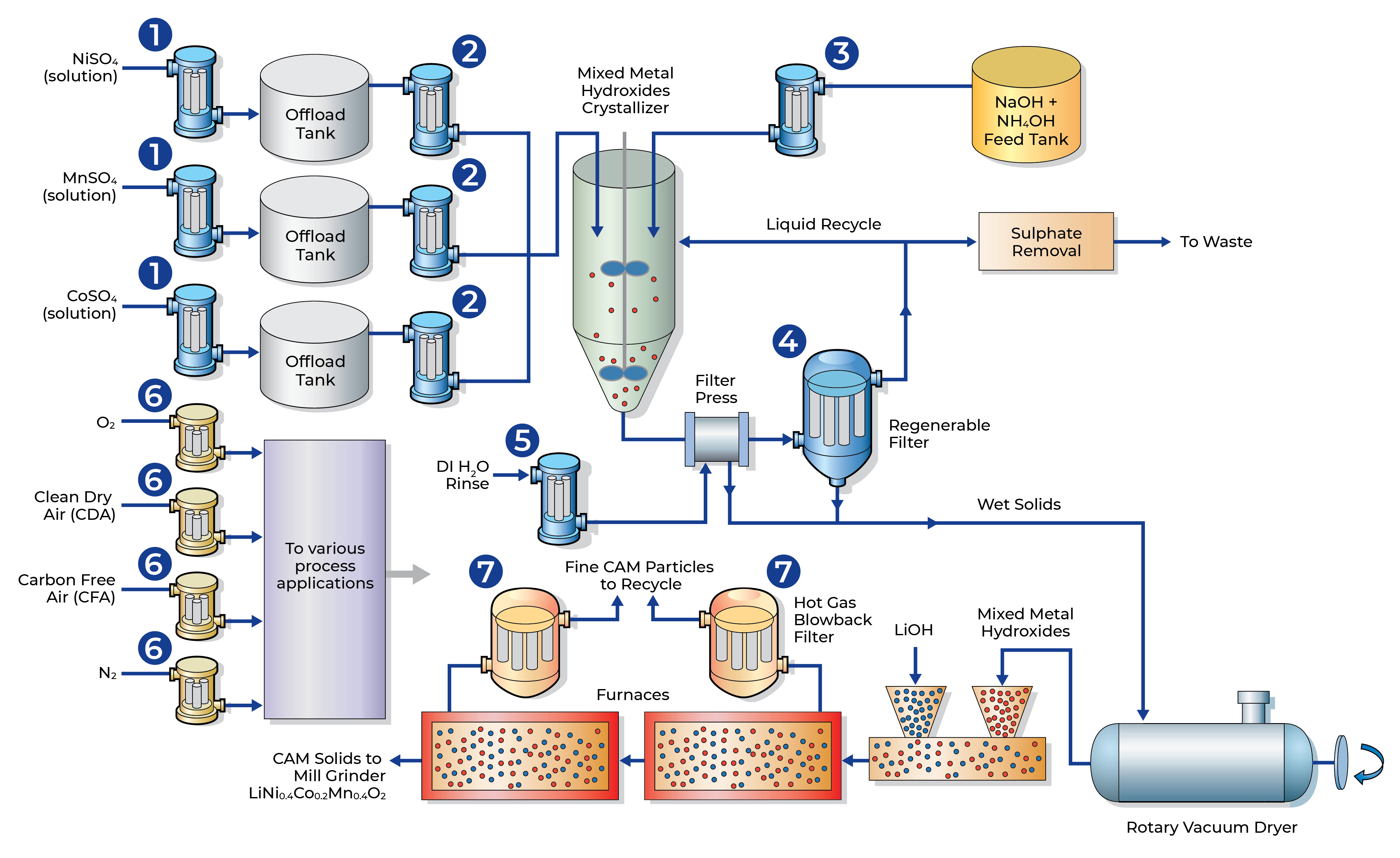Fill out the form below to connect with a Pall expert and discover the right solution for your cathode material production needs.
What Are Cathode Active Materials?
Cathode Active Materials (CAMs) are essential components in the cathode of lithium-ion batteries. These materials undergo electrochemical reactions that enable the storage and release of electrical energy. The choice and purity of CAM significantly impact battery:
- Performance
- Energy density
- Cycle life
- Safety
Watch our video to explore the transformative CAM process and understand how essential filtration enhances battery performance.
What Are the Main Cathode Active Materials in Lithium-Ion Batteries?
There are two primary types of cathode active materials (CAM) used in lithium-ion batteries: NCM (Nickel Cobalt Manganese) and LFP (Lithium Iron Phosphate). Each has distinct characteristics that make them suitable for different applications. NCM offers high energy density and higher voltage, making it ideal for passenger electric vehicles and premium segments where extended driving range is critical. In contrast, LFP provides superior thermal stability, safety, and long cycle life, which makes it the preferred choice for electric buses, two-wheelers, and stationary energy storage systems where cost-effectiveness and durability are key. These differences allow manufacturers to optimize battery performance based on the specific needs of mobility and energy storage markets.
Filtration Challenges in Battery Material Production
CAM manufacturers face several challenges due to the integration of various chemicals and the need to meet strict specifications, including:
- Particle size distribution
- Crystal structure preservation
- Surface area and porosity control
- Contaminant level reduction
- Improve product purity
- Meet cell assembly specifications
These factors are critical to achieving consistent, high-performance battery cells.
-
NCM (Nickel Cobalt Manganese)
-
LFP (Lithium Iron Phosphate)
Filtration plays a critical role in NCM CAM production by ensuring the removal of impurities, controlling particle size distribution, and maintaining chemical purity throughout the process. Effective filtration prevents contamination that can compromise battery performance, enables recovery of valuable materials—ultimately improving yield, consistency, and sustainability in lithium-ion battery manufacturing
Below is a process flow for the CAM process which outlines the essential purification steps:
Filtration locations in the CAM manufacturing process
| No | Application | Filtration Value | Pall Product |
|---|---|---|---|
| 1 | Metal Sulfate Solutions to offload tank | Meet high purity specs for CAM Production | Meta Mesh Filter |
| 2 | Metal Sulfate Solution to Crystallizer | Meet high purity specs for CAM Production | 4.5 Micron Filter |
| 3 | NaOH + NH4OH | Remove undissolved salts, iron oxides and other solid contaminants | 0.5 Micron Filter |
| 4 | Mother Liquor and Water Wash | Recover mixed metal hydroxides | Regenerable Filter |
| 5 | DI Water | Reduce dissolved metals and solid fines in CAM slurry | 0.2 - 10 Micron Filters |
| 6 | Gas Filtration (O2, CDA, CFA, N2) | Remove fine particles from gasses | 0.3 Micron Filters |
| 7 | Hot Gas from Furnaces | Recover fine CAM particles | Hot Gas Blowback Filter |
LFP production, particularly during ferric phosphate synthesis, generates process streams containing valuable solids and impurities. Without advanced filtration, manufacturers risk material loss, equipment fouling, and environmental compliance issues. High-efficiency filtration ensures fine particle removal, maximizes material recovery, and protects downstream systems—supporting sustainable, cost-effective, and reliable LFP manufacturing
Below is a process flow for the CAM process which outlines the essential purification steps:
Filtration locations in the CAM manufacturing process
| No | Application | Filtration Value | Pall Product |
|---|---|---|---|
| 1 | FeSO4, Feed solution | Remove undissolved salts and contaminants | 0.5 Micron Filter |
| 2 | H2O2, Feed solution | Remove undissolved salts and contaminants | 0.5 Micron Filter |
| 3 | H3PO4 Feed solution | Remove undissolved salts and contaminants | 0.5 Micron Filter |
| 4 | Ammonia/ Sodium Hydroxide neutralisation | Purity control and reaction efficiency | 0.5 Micron Filter |
| 5 | DI Water rinse | Remove undissolved salts, iron oxides and other solid contaminants | 0.2 to 10 Micron Filter |
| 6 | Process gases (O2, CDA, CFA, N2) | Remove fine particles from gases | 0.003 to 1 Micron Filter |
| 7 | Mother liquor | Recover fine Iron Phosphate particles | Regenerable Filter |
| 8 | Wash water | Recover fine Iron Phosphate particles | Regenerable Filter |
| 9 | Off-gas from kiln | Recover fine CAM particles | Hot Gas Blowback Filter |
Enhance Your CAM Process with Pall
Pall is a trusted partner in Cathode Active Material Filtration, offering proven solutions to meet the evolving needs of lithium battery manufacturers. Speak to a filtration expert.
Frequently Asked Questions
What is Cathode Active Material Filtration?
Cathode Active Material Filtration is the process of removing contaminants and controlling particle properties during CAM production for lithium-ion batteries. It ensures high purity, structural integrity, and optimal battery performance.





